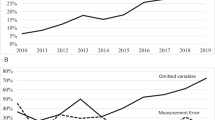Abstract
Patent citations are extensively used as a measure of patent quality. However, counting citations does not account for the fact that citations come from patents of different qualities, and that citations are of variable qualities. We develop a citation index which takes into account the cumulative quality of the citing patents. We apply this index to the 2,139,314 utility patents granted in the U.S. between 1975 and 1999. We study the properties of this index by year and by technological category, and analyse the links between patents.
Similar content being viewed by others
References
Albert, M., Avery, D., Narin, F., McAllister, P. (1991), Direct validation of citation counts as indicators of industrially imoprtant patents, Research Policy, 20: 251–259.
Bacchiocchi, E., Montobbio, F. (2004), EPO vs USPTO Citation Lags, WP n. 161, CESPRI, Universitá Commerciale Luigi Bocconi.
Bosworth, D. L. (2004), The Ancestral Tree of IPC C12S: A Preliminary Exploration Based on a Sample of Two, Melbourne University.
Cameron, C., Trivedi, P. (1986), Econometric models based on count data: Comparison and applications of some estimators and tests, Journal of Applied Econometrics, 1: 29–54.
Cohen, W. M., Nelson, R. R., Walsh, J. P. (2000), Protecting Their Intellectual Assets: Appropriability Conditions and Why U.S. Manufacturing Firms Patent (Or Not), NBER Working paper 7552.
Duguet, E., MacGarvie, M. (2003), How Well Do Patent Citations Measure Flows of Technology? Evidence from French Innovation Surveys, Cahiers de la MSE — EUREQua 2003(99).
Eerden, C., van der, Saelens, F. H. (1991), The use of science and technology indicators in strategic planning, Long Range Planning, 24: 18–25.
Fahrmeir, L., Tutz, G. (1994), Multivariate Statistical Modelling Based on Generalized Linear Models, Springer.
Gay, C., Le Bas, C. (2005), Uses without too many abuses of patent citations or the simple economics of patent citations as a measure of value and flows of knowledge, Economics of Innovation and New Technology, 14(5): 333–338.
Gourieroux, C., Monfort, A., Trognon, C. (1994a), Pseudo-Maximum Likelihood Methods: Theory, Econometrica, 52: 681–700.
Gourieroux, C., Monfort, A., Trognon, C. (1994b), Pseudo-Maximum Likelihood Methods: Applications to Poisson Models, Econometrica, 52: 701–720.
Greene, W. (1995), LIMDEP, Version 7.0: User’s Manual. Bellport. N.Y. Econometric Software, pp. 234–241.
Greene, W. (1997), Frontier Production Functions, In: Pesaran, M., Schmidt, P. (Eds), Handbook of Applied Econometrics: Volume 2: Microeconomics. London: Blackwell Publishers.
Greene, W. (2002), Econometric Analysis, Prentice Hall.
Gurmu, S., Trivedi, P. (1994), Recent Developments in Models of Events Counts: A Survey, Manuscript, Department of Economics, Indiana University.
Hall, B. H., Jaffe, A. B., Trajtenberg, M. (2000), Market Value and Patent Citations: A First Look, NBER Working paper 7741.
Hall, B., Jaffe, A., Trajtenberg, M. (2001), The NBER Patent Citations Data File: Lessons, Insights and Methodological Tools, NBER Working Paper 8498.
Hall, B. H., Trajtenberg, M. (2004), Uncovering GPTS with Patent Data, NBER Working Paper 10901.
Harhoff, D., Narin, F., Scherer, F. M., Vopel, K. (1998), Citation frequency and the value of patented inventions, Review of Economics and Statistics, 81: 511–515.
Hirschey, M., Richardson, V. J., Scholz, S. (2001), Value relevance of nonfinancial information: The case of patent data, Review of Quantitative Finance and Accounting, 17: 223–235.
Jaffe, A. B., Trajtenberg, M., Fogarty, M. S. (2002), Knowledge spillovers and patent citations: Evidence from a survey of inventors, American Economic Review, 90(2): 215–218.
Kochen, M. (1974), Principles of Information Retrieval Wiley, N.Y.
Lanjouw, J. O., Schankerman, M. (1999), The Quality of Ideas: Measuring Innovation with Multiple Indicators, NBER Working Paper 7345.
Lanjouw, J. O., Schankerman, M. (2004), Patent quality and research productivity: Measuring innovation with multiple indicators, Economic Journal, 114(495): 441–465.
Maurseth, P. B. (2002), Lovely but Dangerous: The Impact of Patent Citations on Patent Duration.
Meyer, M. (2000), What is special about patent citations? Differences between scientific and patent citations, Scientometrics, 49(1): 93–123.
McCullagh, P., Nelder, J. A. (1989), Generalized Linear Models, 2nd Edition, Chapman & Hall.
Narin, F., Olivastro, D. (1988), Technology indicators based upon patents and patent citations, In: Raan, A. F. J. (Ed.), Handbook of Quantitative Studies of Science and Technology, North Holland: Elsevier.
Neary, J. P. (2003), Evaluating economics research in Europe: An introduction, Journal of the European Economic Association, 1(6): 1239–1249.
Palacios-Huerta, I., Volij, O. (2002), The Measurement of Intellectual Influence.
Pinski, G., Narin, F. (1976), Citation influence for journal aggregates of scientific publications: theory, with application to the literature of physics, Information Processing & Management, 12: 297–312.
Scientific American (1999), Hypersearching the Web, June, 54-60.
Terza, J. V. (1998), Estimating count data models with endogenous switching: Sample selection and endogenous treatment effects, Journal of Econometrics, 84(1): 129–154.
Trajtenberg, M. (1990), A penny for your quotes: Patent citations and the value of innovations, RAND Journal of Economics, 21(1): 172–187.
Trajtenberg, M., Henderson, R., Jaffe, A. B. (2002), University versus corporate patents: A window on the basicness of invention, In: Jaffe, A. B., Trajtenberg, M. (Eds), Patents, Citations and Innovations: A Window on the Knowledge Economy, The MIT Press, Cambridge, M.A.
Wooldridge, J. M. (1990), Quasi-likelihood methods for count data, In: M. Hashem Pesaran, P. Schmidt (Eds), Handbook of Applied Econometrics, Volume 2, Blackwell, pp. 352-406.
Author information
Authors and Affiliations
Rights and permissions
About this article
Cite this article
Atallah, G., Rodríguez, G. Indirect patent citations. Scientometrics 67, 437–465 (2006). https://doi.org/10.1556/Scient.67.2006.3.7
Received:
Published:
Issue Date:
DOI: https://doi.org/10.1556/Scient.67.2006.3.7




